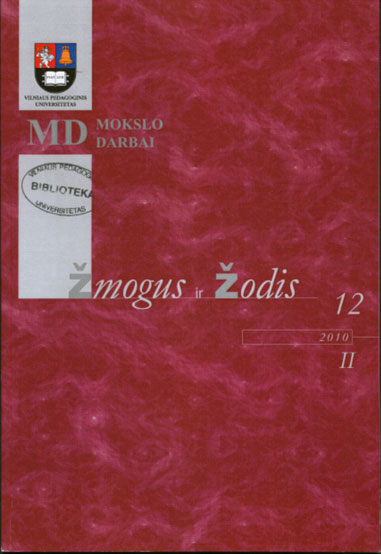Sakymas vaizdažodiniuose tekstuose
Enunciation in Iconotexts
Author(s): Andrius GrigorjevasSubject(s): Literary Texts
Published by: Vytauto Didžiojo Universitetas
Keywords: enunciation; utterance; shifting out; shifting in; enunciator; enunciatee; iconotext; history; discourse; auto-reference; bricolage; integrated reflection.
Summary/Abstract: In this article the theories of enunciation are presented as a methodological tool for analyzing iconotexts. The definition of enunciation is based on theories of Algirdas Julien Greimas and Emile Benveniste. In semiotic researches by Jean-Marie Floch and Felix Thürlemann the structures of enunciation are also reconstructed in non-written texts. Film theoreticians Francesco Casetti and Christian Metz are searching for enunciation equivalents in film language. In the texts Linoraižiniai pasakai Eglė žalčių karalienė (1968) and Našlaitė Elenytė ir Joniukas aviniukas: lietuvių liaudies pasaka (1971) by Petras Repšys, the elements of enunciation become a form of textual reflexivity. The unity between the visual and written texts allows describing the enunciation subject and his attitude towards the enunciated text. The written discourse presents figures and their values which are later reinterpreted using the enunciation figures on the meta-textual level. In the first text the elements of visual discourse reveal multilayered visions of the tale world by reinterpreting the written discourse. The subject of enunciation constructs a new text by using his own experience, mythological fairy-tale figures, graphical forms and etched Lithuanian runes. In the rewritten fairy-tale Našlaitė Elenytė ir Joniukas aviniukas the visual and written discourses create autonomous utterances. Visual discourse interprets the figures which appear in the written discourse on a meta-textual level. The enunciation isotopy is sustained by visual figures of author and plant. In both texts the reader’s figure is involved in the situation of enunciation. What was expected to be an illustration book becomes an independent text which speaks of its own being.
Journal: Žmogus ir žodis
- Issue Year: 12/2010
- Issue No: 2
- Page Range: 46-51
- Page Count: 6
- Language: Lithuanian

